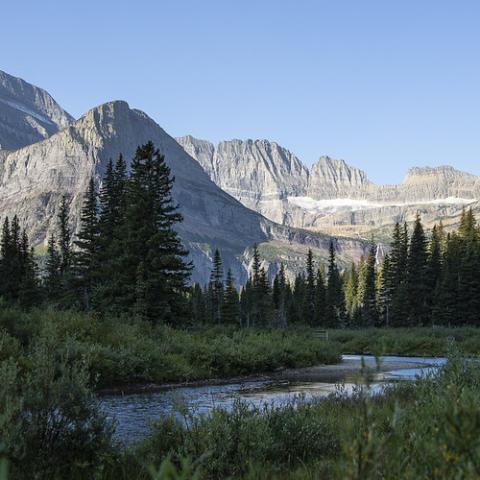
Bison calf born at Oakland Zoo in 2018 from bison stock from Blackfeet Nation/Steven Gotz
A carefully planned effort to boost the bison herd at the Oakland Zoo in California with animals from the Blackfeet Nation adjacent to Glacier National Park has proved unexpectedly successful, and now most of the bison loaned to the zoo have been sent back to the reservation.
It was just more than a year ago that the Blackfeet Nation sent 14 bison to the zoo. What wasn't realized at the time was that many of the cow bison that were loaned arrived pregnant, and gave birth to 10 calves.
Now 11 of the bison are back with the Blackfeet Nation, having arrived Tuesday. This return of the calves (and mothers) is part of the Bison Restoration Project, i.e., the ‘Iinnii Initiative,’ to restore free-roaming bison to Blackfeet land and nearby Glacier and Waterton Lakes national parks. These bison females and their calves descended from the iconic ‘Pablo-Allard’ herd and have been living in their 13-acre habitat at the California Trail for the past year.
"Since we didn’t expect the females to calf last year, Mother Nature nudged us into returning the bison to the wild a bit sooner than planned. Luckily, we were well prepared, and have really enjoyed watching them grow,” said Darren Minier, assistant director of animal care at Oakland Zoo.
Oakland Zoo’s Animal Care staff took into consideration the critical social bonds within the herd in determining which calves and mothers would go back to Montana. Female offspring stay with their mothers and aunts for the duration of their lives. It has been proven that animals have more success in the wild when released with familiar individuals.
The Pablo-Allard herd arose at the end of the 19th century with two ranchers in northern Montana, not far from where present-day Glacier National Park is located, started a small bison herd. It eventually grew to several hundred animals. While most of the herd was sold to Canada in the early 1900s, some animals were sent to Yellowstone National Park in 1902 to help enlarge the park's bison population, which numbered fewer than 25 at the time. More recently, the Blackfeet Nation acquired many of its bison from Elk Island National Park in Canada, where the Pablo-Allard herd was sent more than a century ago.
So as to diversify the genetics of zoo herd’s future offspring, which will continue to be sent (along with the mothers) back to Blackfeet land and to Glacier National Park, two male bison will soon join the zoo’s remaining females. The two bulls were born of a non-surgical embryonic transfer technique developed by Dr. Jennifer Barfield of Colorado State University in Fort Collins, and the Wildlife Conservation Society. This enables the zoo to introduce the new genetic line, thereby diversifying the genetics of the Pablo-Allard herd, without risk of exposure of any wildlife-associated diseases.
While bison don't currently roam Glacier, park staff are open to the idea of a free-roaming herd moving back and forth between the adjacent Blackfeet Nation lands and Glacier.
Oakland Zoo and Blackfeet Nation partner in educational programs and support mutual interest in promoting bison conservation and culture preservation. This partnership includes youth exchange for education, fundraising for projects, and promotion of eco-tourism programs.
“It is an honor to be a part of the Iinnii Initiative in bringing American Bison back to the Blackfeet Nation people,” said Amy Gotliffe, director of conservation at Oakland Zoo. "These returning bison and those in the future will play a critical role in re-populating the open range."




 Support Essential Coverage of Essential Places
Support Essential Coverage of Essential Places







Comments
One correction should be noted, Dr. Jennifer Barfield is at Colorado State University, not the University of Colorado. Please see http://csu-cvmbs.colostate.edu/Pages/faculty-profile-jennifer-barfield.aspx
Good catch, Steve. That's how the release had her listed, but we should have caught that. We'll fix the story. Thanks.